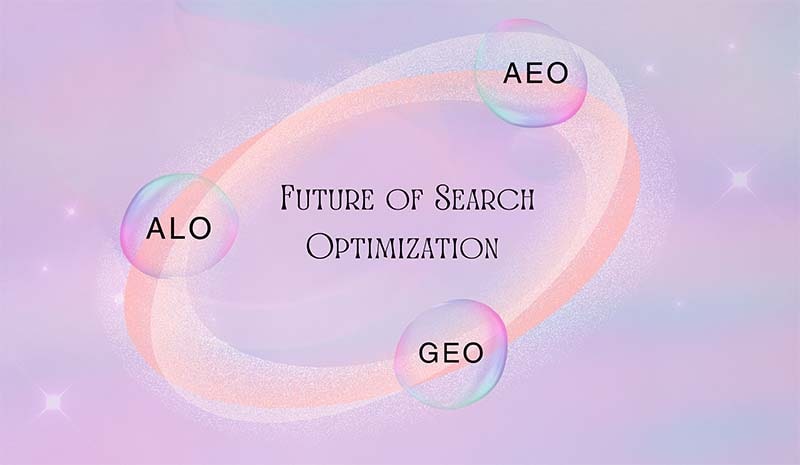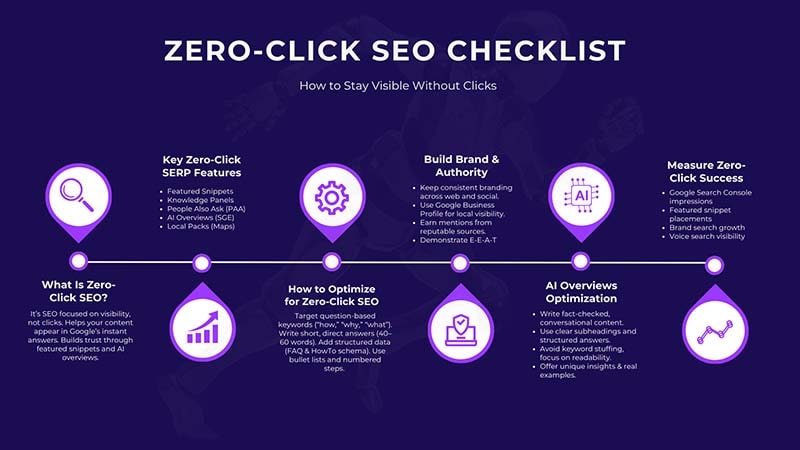The search world has always been changing and it was no different with the introduction of Generative AI, conversational assistants, and large language models (LLMs) that are now not just tools but the gatekeepers of information discovery. In 2025, we are witnessing a major change:
- SGE by Google delivers AI-written summaries before traditional results.
- ChatGPT, Claude, Perplexity, and Gemini are replacing “search” for millions of users.
- Voice assistants (Siri, Alexa, Google Assistant) are moving toward answer-first search.
SEO in this new era is all about targeting machines that produce, think, and answer rather than simply algorithms.
The first one among the three new pillars of SEO is ALO (AI Language Optimization), making sure that AI understands and decorates your content with the help of the context.
Next comes AEO (Answer Engine Optimization) – making sure that your brand is the one that comes in direct answers.
And finally, there is GEO (Generative Engine Optimization) – making sure that generative AI gets your content, credits it, and cites it.
This manual will dissect each type, delve into the compatibility with traditional SEO, and demonstrate you the precise steps to be still relevant online in the coming years.
1. What is ALO (AI Language Optimization)?
ALO (AI Language Optimization) is a practice and a process of adjusting your content for LLMs (Large Language Models) such as GPT-5, Gemini, and Claude.
Why ALO Matters in 2025
The main aim of traditional SEO is to make content readable by crawlers. However, LLMs don’t only crawl—they comprehend the meaning, derive the context, and produce the result.
Just to illustrate:
Suppose a person queries “What’s the difference between ALO and GEO in SEO?”; Then Google SGE or ChatGPT won’t answer straight away but rather get information from various sources, compare, and deduce differences, thus producing a new answer.
If your content lacks semantic structure, LLMs can still be wrong in their delivery of your content or may even bypass your site altogether.
Core Principles of ALO
Semantic Structuring
- Try using topic clusters: write pillar pages to cover the broad topics, and then create the detailed subpages that work for you to interlink.
- To make AI find the context fast, add your schema markup (FAQ, Article, HowTo, Product).
Entity Enrichment
- Introduce the relevant concepts: for instance, besides ALO also write articles about “semantic SEO,” “structured data,” “Google Knowledge Graph.”
- By means of entity linking (outbound references to Wikipedia, authoritative sites), you not only facilitate navigation but also enhance the context strength.
Conversational Design
- Large language models prefer the structured question-answer format, so format your sections accordingly. Example:
Q: What is ALO in SEO?
A: ALO stands for Artificial Language Optimization, and it is a method of content optimization focused on LLMs…
Context Expansion
- Do not produce thin content. To satisfy AI models, content needs to be complete. One should cover ‘what, why, how, pros/cons, examples, and future outlook’ in their article.
Trust & Authority Signals
- Support your arguments using studies, expert quotes, and references to research.
- Large Language Models prioritize authoritative content.
Pro Tip: Imagine ALO to be a creator producing content not only for humans or Google, but for AI “instructors” who would subsequently comprehend your text and distribute it to countless others.
2. What is AEO (Answer Engine Optimization)?
AEO (Answer Engine Optimization) targets answer-first platforms such as:
- Google SGE
- Bing Copilot
- Perplexity AI
- Voice search assistants (Alexa, Siri, Google Assistant)
Why AEO Matters
By 2025, most of the queries are zero-click searches.
Users no longer click through multiple links, they simply read the AI-generated answer.
Anyway, if your content is not formatted as an answer, you are invisible to the search.
AEO in Action
Example: User asks Google:
“How does generative engine optimization work?”
Rather than listing 10 links, Google SGE produces:
“Generative Engine Optimization (GEO) is the practice of creating content in a way that AI-powered search engines adopt it as a source for new content. This process includes structured data, attribution, and topical depth.”
When your content is crafted around brevity, transparency, and knowledge, you end up being the source.
AEO Best Practices for 2025
Snippet Optimization
- For each major key concept, create 40-60 word summaries.
- Example: “Answer Engine Optimization (AEO) is the process of…”
FAQ Sections
- Insert structured FAQs at the end of blog posts.
- Implement FAQ schema to achieve rich snippets.
Voice Search Optimization
- Qualify voice search queries with conversational style typical of spoken language (“What is the best strategy for ALO in 2025?”).
- Long-tail question keywords help to open up the particular topic.
Entity SEO
- Connect your brand/content with knowledge graph entities.
- Example: Linking ALO to “SEO trends 2025,” “semantic search,” “LLMs” etc.
Zero-Click Strategy
- Do not fight the fact that there will be times when users do not click.
- Make sure that your brand is still visible in the AI-generated answer.
Pro Tip: AEO is not about ranking, it is about being the one who gives the answer.
3. What is GEO (Generative Engine Optimization)?
GEO (Generative Engine Optimization) is the future of SEO, just as Google was a revolution in search. Basically, it means designing content in such a way that AI content generators (like SGE, ChatGPT, Perplexity, and Bing Copilot) not only get your content for reference or answering, but also actively pick and give a credit to your content in their written output.
Why GEO Matters
Generative engines pull information from various sources to write a summary by themselves. If your content is not authoritative, well-structured, or comprehensive, AI might:
- Bypass your content completely.
- Extract your ideas without giving you the credit.
The idea of GEO is, however, to let the AI know that it is you that it should quote.
GEO Optimization Strategies
Attribution-First Content
- Use your brand name as a part of the text, openly:
“As [Brand] stated, the best way to implement ALO is…”
- Supporting AI systems to link the source.
Data & Structure Formatting
- Show the information in tables, lists, figures, and charts.
- Most generative engines prefer organized, easily readable data.
Comprehensive Coverage
- Go through all the aspects of a topic.
- Never get chosen for the write-ups of minimal length; the deep guides take over the market.
Freshness & Updates
- AI-fueled units prefer current information.
- Update articles with new stats every quarter.
Cross-Channel Validation
- Make sure that the content of your blog, LinkedIn, YouTube, and podcasts is in line.
- The AI engines that have multi-format authority are the ones that are considered the most.
Pro Tip: GEO is related to how much AI trusts you as the most reliable source.
4. ALO vs AEO vs GEO: The Key Differences
| Aspect | ALO (AI Language Optimization) | AEO (Answer Engine Optimization) | GEO (Generative Engine Optimization) |
| Focus | AI comprehension | AI answering | AI generation & citation |
| Primary Goal | Help LLMs interpret content | Appear in AI-driven answers | Be chosen & credited in AI outputs |
| Audience | Large Language Models (ChatGPT, Gemini) | Search Generative Engines, voice assistants | Generative AI (SGE, Copilot, Perplexity) |
| Best Tactics | Semantic SEO, schema, entity linking | FAQ schema, snippets, voice Q&A | Structured data, attribution, comprehensive guides |
| Risks of Ignoring | Content misunderstood or skipped | Brand invisible in zero-click results | AI uses your ideas without credit |
5. Future of SEO (2025 and Beyond)
The largest change in the mindset:
SEO has changed from merely ranking web pages to a new level of interaction where AI is instructed to clarify, endorse, and reference your brand.
- ALO makes it possible for AI to comprehend your business.
- AEO makes sure that AI picks up your business when it generates the answer.
- GEO makes sure that AI acknowledges your business as the source of information.
Predictions for 2025–2030
- An AI-first indexing – It’s possible that Google will transition from web-first to an AI-first index, where the priority will be given to the structured, LLM-ready content.
- The coming of “AI Citation SEO” – GEO will become a field as large as the link-building one was.
- Brand-as-Entity Optimization – The competition will be among brands trying to be the one getting recognized in the “knowledge graph entities” category.
- AI-Native Analytics – The new SEO tools will provide information about the places and ways in which your brand is referred in AI outputs.
- Multimodal SEO – The technology of AI will fetch not only the required text but also the relevant images, charts, and videos to provide the answer to the user’s query.
6. Practical Checklist for Marketers
- ALO: Employ schema, entity linking, and conversational structure.
- AEO: Produce FAQs, summaries, and snippet-friendly answers.
- GEO: Concentrate on attribution, structured data, and topical depth.
- Update evergreen content regularly.
- Keep track of AI-generated content that refers to your brand.
- Establish expertise through various content forms (text, video, audio).


